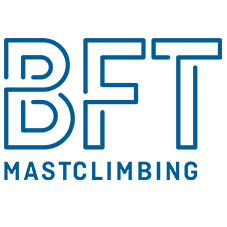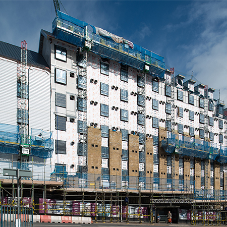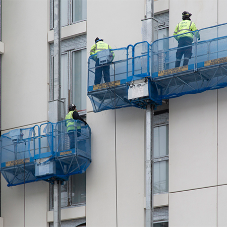You’re probably reading this after searching for more information on mast climbers after realizing they are a great alternative to scaffolding.
How much do they cost? When should they be used? How can they benefit your next construction project?
You might even be here after discussing mast climbers with a colleague or being tasked with finding alternative vertical access options.
That’s the exact reason BFT Mastclimbing created this article. Answering all of the most common FAQs surrounding mast climbers and the mast climber industry, it will provide you with the confidence that they are a suitable form of access for your next project and those after it.
Understanding what exactly a mast climber does is only the start. This post explores the advantages they bring to your project, the differences between them and scaffolding and even highlights a powerful tool which estimates time and cost savings.
What Are Mast Climbers?
A fully customisable, vertically travelling platform attached to the outside of a building, a mast climber is a common vertical access option that is used in the construction industry alongside more traditional scaffolding.
Powered by a drive unit that moves the platform using a rack and pinion actuator, the mast climber travels up and down vertical one or more vertical masts giving workers access to the entire external façade of a building.
Available in a range of sizes and payloads, mast climbers are promoted by IPAF (International Powered Access Federation) and can be used on multi-storey buildings of all varieties.
While in the UK they are most commonly known as mast climbers, across the globe they are also often referred to as motorised scaffolding. However, for the purpose of simplicity, BFT Mastclimbing will stick to the recognised names in the UK that include mast climbers, mast climber work platforms or MCWPs.
What Are The Advantages of Mast Climbers?
• Reduce the overall time spent on completing construction projects.
• Help slash costs on your construction projects.
• Improve the sight of your project which is better for the local community.
• Protect residents from feeling trapped in their own homes, limiting daylight and airflow.
• Easily adapted to work for your construction project.
• Customised to suit your individual façade.
• Protect workers from musculoskeletal injuries as they can work at the optimum height.
What Are The Disadvantages of Mast Climbers?
• They’re not suited to 1 & 2 storey buildings.
• It is essential that operators are trained on how to safely operate them.
• They can’t fully enclose a building.
• Project work has to be planned more methodically.
• New technologies aren’t often accepted for some time.
A Mast Climber’s Top 3 Features
1. FEATURE #1: Mast Climbers Are A Single Platform
This design, paired with its manoeuvrability up masts means mast climbers give workers the ability to work at the correct height for the tasks they need to complete.
This is significant if you’re concerned about health and safety as some of the most common issues experienced by construction workers relate to working in awkward positions.
When using a mast climber, the operator can drive it to any height and complete the work at the optimum level. Not only does this get work completed quicker, but it gets it completed much safer for your operatives, too.
2. FEATURE #2: Mast Climbers Are Modular
12ft tubes, wooden boards, essential fittings…
When erecting scaffolding around your high-rise building, there are a lot of individual components that need to combine together.
That’s time that you could potentially save with a mast climber for one good reason.
Where scaffolding is loose components delivered by multiple wagons that need fitting together with pinpoint accuracy, a mast climber, because of its modularity, can be delivered in far fewer batches, reducing your carbon footprint and on-site logistical challenges, too.
These much larger modules mean that in its most simple form, a single platform can be fixed to a mast and the work can commence.
With some essential safety checks and certifications approved, you can gain access to your external façade in as little as 2-days. Compare that with the 12 or so days it takes to assemble scaffolding to 40m, and you can begin to see the differences.
3. FEATURE #3: A Mast Climber Is Aesthetically Pleasing
Aesthetics might not be top of the list when you’re selecting your vertical access, but it should be a factor that you consider.
Not only does scaffolding entirely enclose a building, but it also makes it difficult for project managers to view progress from the bottom of the building. Instead, they’re forced to climb the scaffolding, the higher this is the longer that will take.
There’s also evidence to suggest that if workers can be seen doing their job, they will work more efficiently. With no scaffolding to hide behind, having a mast climber on your building’s exterior means work and workers can be seen from the ground.
But flip this for just a moment. Imagine if the building was residential and inside were hundreds of people who felt ‘trapped’ by the scaffolding and monarflex on its exterior.
This is a genuine concern for residents and housing authorities up and down the country. Choosing a mast climber instead or alongside scaffolding, helps remove any concerns residents might have about the lack of daylight or airflow in their homes.
Working At Height: When Should You Use A Mast Climber?
Mast climbers start to show their true value when working on anything above 3 stories.
In fact, at 6 floors, a mast climber could see you save 13% in costs comparatively to scaffolding; this saving continues to increase the taller your building is. There’s a 61% saving at 12 floors, 73% at 18 floors, and once you start going above 25 floors, you’re looking at an 80% saving.
A huge portion of this cost saving comes when you compare the erection and dismantling of both mast climbers and scaffolding. On your average 40m high building, it would take 2 weeks to erect the scaffolding.
With a mast climber, it would be 2 days.
Because it’s modular and easily assembled, the process is far slicker and more streamlined than the assembly of individual scaffolding components.
What Are The Differences Between Mast Climbers & Scaffolding?
Although both provide vertical access to the exterior façade of a building, there are inherent differences between MCWPs and scaffolding.
In an ideal situation, the best form of vertical access is a hybrid solution that uses scaffolding for public protection through pedestrian tunnels and bridges, while the mast climber itself is used for vertical access.
The differences are noticeable in more ways than one, though:
• Mast climbers provide cost savings. The taller the building the greater the saving, too.
• There are huge differences in the erection and dismantle times. Mast climbers are far quicker, slashing the time to assemble significantly.
• Mast climbers are a single platform limiting the number of trades that can be working at one time.
• Mast climbers allow workers to complete tasks at the optimal height for their trade.
• The accuracy of a mast climber helps trades work safer, preventing common injuries.
• Logistically, projects need to be planned accordingly. Scaffolding may require 4 or 5 deliveries; a mast climber is modular and therefore requires fewer.
Mast Climbers: What Can They Be Used For?
Mast climbers are suited to 85% of all construction projects. These jobs are listed in the next section.
What this section highlights are two key forms of construction work that mast climbers are most commonly used for.
1. Work #1: Recladding
The government has set aside £3.5bn with the intention of fixing dangerous cladding on all residential high-rise buildings. What that means is that that there is going to be a huge influx in recladding work over the course of the next 12-18 months.
When it comes to selecting your vertical access, you want to be able to complete the job without causing any further disruption to those within the building.
You only have to hear it from residents who are ‘trapped’ within their own homes as recladding work is being completed.
“There’s no way human beings should have to live like this” Natalie Carter explains in in a previous interview.
Thinking about the resident’s within is equally, if not more important than thinking about the success of your project. It’s why d+b facades Cliff Woodhouse suggests that “scaffolding presents us with various problems. Firstly, it’s just not flexible enough for what you need.”
If you’re recladding, you need flexibility, and if you want flexibility, you want a mast climber.
2. WORK #2: Brickwork
Laying bricks is a labour-intensive task. Moving heavy materials and working at a variety of heights, the work itself is perfect for a mast climber.
With scaffolding, the levels are fixed. As work progresses, workers have to stretch, stoop and bend, putting their bodies as risk. This problem is removed with a mast climber making it an ideal vertical access option for the bricklaying trade. The MCWP can be driven to the optimum height and ‘chase’ the brickwork as it ascends the building one brick at a time.
Loading and unloading materials onto scaffolding is a huge bottleneck, too.
The higher the building the more elaborate the lifting equipment required. This doesn’t even factor in the time carrying the equipment to the designated section of scaffolding.
The mast climbing work platform takes all of this away. In fact, timing your descents allows for teams to load up the platforms in synchronisation with comfort breaks, streamlining entire projects.
Brickworkers in the north of England of are using mast climbers more and more frequently. In fact, Neil Allen from CARA Brickwork states that; “we [CARA Brickwork] are one of the biggest bricklaying contractors in the North, we work on some of the biggest jobs so if we’re happy to use them other companies should too.”
What Construction Work Are Mast Climbers Suited To?
• General building development & construction work 3-storeys and higher.
• Reparative work and maintenance on the external façade of high-rise buildings.
• Replacing damaged glazing and window frames
• Guttering repairs for systems high off the ground
• Post-Grenfell recladding and combustible cladding removal
• Rendering and external façade repair.
Are Mast Climbers Better For Project Efficiency?
Mast climbers can be assembled and dismantled much quicker than other vertical access options which helps streamline your projects. Delivered on fewer wagons than scaffolding, and easier to assemble, the entire project runs smoother when there’s an MCWP.
The quicker you can commence work, the quicker you can finish and start other projects for your business.
Mast climbers are also more efficient from the point of view of the workers too. Because the mast climber is a moveable platform, it can be driven to any required height, unlike scaffolding which has set levels.
This means whether it’s rendering teams, brick workers, re-cladders or electricians; any potential trade on-site can work at the preferred height. In doing that, the work will be completed safely and more efficiently.
Can You Work Out How Much A Mast Climber Could Save You?
BFT has created a calculator that helps project managers, quantity surveyors, developers and contractors work on how much money and time a mast climber can save.
Available on the homepage of the website, all you need to do is enter the height and width of your next project. The results are an estimated number of days saved overall as well as a percentage cost saving when you compare mast climbers and scaffolding.
It’s a tool that many people in the vertical access sector have been asking about and it’s available, for free!
Mast Climbers – Now You know
Now you have all the available information. Whether it’s through data and comparisons, images and videos, or first-hand experience from trades and residents, you’re now up to speed with all the basics surrounding mast climbing work platforms.
The question is, what’s stopping you from speaking to one of the experts at BFT Mastclimbing?
With this guide, their shorter form informative pieces and their free guide on MCWPs, it’s obvious they are a valuable vertical access solution for your construction project. Why not get a price or find out more?
With a background in scaffolding, BFT Mastclimbing’s team know everything there is to know about mast climbing, so if you have remaining questions, want to book training courses or are ready for a comparative cost, then get in with the team who will be glad to offer expert advice.
Email: rob.munns@bftmastclimbing.com
Phone: 07971 952773
Mast Climbers: Everything You Need To Know
| T | 0808 178 9772 |
|---|---|
| E | rob.munns@bftmastclimbing.com |
| W | Visit BFT Mastclimbing Ltd's website |
| The Rear Yard, Lancer Court, Grovebury Road, Leighton Buzzard, Bedfordshire, LU7 4SE |





